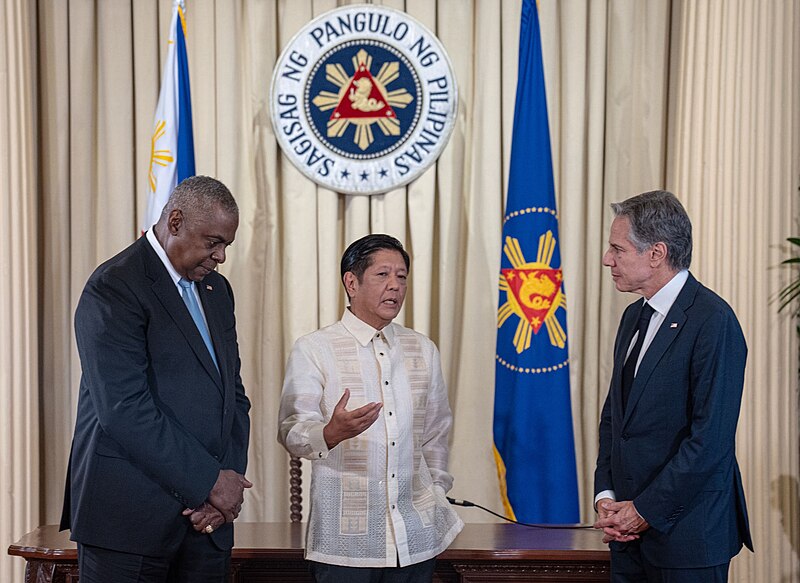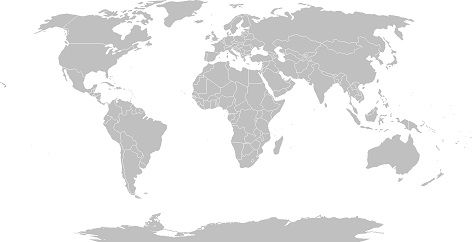Abstract:
The United States (US) and its Southeast Asian non-NATO major ally, the Philippines, have just concluded the fourth US – Philippines 2+2 Ministerial Dialogue hosted in Manila on July 30, 2024. In Part 1 of this special report, Contributing Writer Mark Davis Madarang Pablo examines the key takeaways from this historic meeting. This analysis will highlight the political uncertainty as well as policy and strategy gaps that the Philippine Government under President Ferdinand Marcos, Jr. must urgently address. This will ensure the effective implementation of the signed agreements and contribute towards the preservation of peace and stability in the West Philippine Sea.
US – Philippine Security Alliance Back on Track
US – Philippine bilateral security relations are currently at an all-time high. US Defence Secretary Lloyd Austin III and Secretary of State Antony Blinken met with Philippine President Ferdinand Marcos, Jr. on July 30, 2024 as part of Austin’s historic eleventh official visit to the Indo-Pacific—one of the ministerial-level meetings spearheaded by Washington in partnership with its security allies including Japan, South Korea, the Philippines, and Australia. These meetings are aimed at unifying like-minded countries towards the preservation of the rules-based international order (RBIO) in this geopolitical hotspot. During their state visit to Manila, Austin and Blinken touted the re-strengthening of US – Philippine bilateral security relations, which was strained during the administration of former Philippine President Rodrigo Duterte who then sought to pivot towards China. Austin and Blinken reiterated Washington’s ironclad support for Manila’s assertion of its sovereign rights, especially in the hotly contested West Philippine Sea. They also expressed their determination to work closely with like-minded countries in upholding the vision of a free and open Indo-Pacific.
Defence Secretary Gilberto Teodoro and Foreign Affairs Secretary Enrique Manalo, reaffirmed their shared commitments under the 1951 Mutual Defence Treaty (MDT), and acknowledged the significance of the 1998 Visiting Forces Agreement (VFA) and 2014 Enhanced Defence Cooperation Agreement (EDCA) as the enduring twin pillars of the security treaty alliance. The Secretaries clarified that the MDT “extends to armed attacks against either country’s armed forces, aircraft, and public vessels—including those of coast guards—anywhere in the South China Sea.” They vowed to follow through on the stated plans from the third US – Philippines 2+2 Ministerial Dialogue in April 2023 and the 11th Bilateral Strategic Dialogue in April 2024, to deliver a new round of security aid package, expand avenues for bilateral cooperation in the security sector, and re-integrate the Philippines further within the broader Indo-Pacific security alliance network.
Key Takeaways during the Fourth US – Philippines 2+2 Ministerial Dialogue
Austin and Blinken pledged that the US shall work closely with the US Congress to support territorial defence and maritime security operations by allocating US$500 million worth of Foreign Military Financing (FMF) from the FY 2024 Indo-Pacific Security Supplemental Appropriations Act for the modernization drive and capability enhancement of the Armed Forces of the Philippines (AFP) and the Philippine Coast Guard (PCG). This funding will complement—and possibly accelerate—the Philippine Government’s Revised Horizon (Re-Horizon) 3 of the AFP Modernization Program approved by Marcos, Jr. in January 2024. This program seeks to allocate US$35 billion worth of domestic funding for the acquisition of external defence assets, equipment and platforms for enhanced power projection and more effective response to security-related contingencies in the West Philippine Sea. Identified acquisitions under this initiative include: land-based radar and airborne surveillance systems, multi-role fighters (MRFs), submarines, anti-access/area denial systems, and anti-submarine warfare helicopters. Aside from the infusion of fresh funding for military and coast guard modernization, the Secretaries also agreed to implement a wide range of security proposals, such as:
- Establishment of Roles, Missions, Capabilities (RMC) Working Group for enhanced policy and operational coordination on joint defence operations and activities;
- Implementation of the Philippines – Security Sector Assistance Roadmap (P-SSAR) which shall guide shared defence modernization planning and investments, including the delivery of priority platforms within the next five- to ten-year time frame;
- Increase in investments in EDCA locations—which, as of writing, have expanded from five to nine military bases—for combined training, exercises, and interoperability between the US and Philippine militaries as well as civilian-led disaster preparedness and response;
- Conclusion of the General Security of Military Information Agreement (GSOMIA) by year end which would bolster information and defence technology-sharing between the two allies; and
- Provision of support for the creation of a new Cyber Command and training of a highly capable and skilled cyber workforce; and the expansion of cooperation and interoperability of the US and Philippine Coast Guards.
Fragile Peace in the West Philippine Sea
The reinvigoration of US – Philippine bilateral security relations could be attributed largely to Marcos, Jr.’s political decision to pivot back to the US at a critical juncture when Washington is prioritizing the Indo-Pacific region as its new geostrategic focus area. Manila’s so-called “policy pivot” back to Washington is a strategic response to China’s rejection of the 2016 Permanent Court of Arbitration ruling in The Hague. This ruling invalidated Beijing’s nine- (and later ten-) dashed line and maritime entitlement claims around its artificial islands in the Kalayaan Island Group (KIG), internationally known as Spratly Group of Islands, followed by the unilateral intensification of its anti-access/area denial (A2/AD) strategy in the West Philippine Sea through its gray zone tactics.
According to the Asia Maritime Transparency Initiative based in the Center for Strategic and International Studies: “Since 2013, China has engaged in unprecedented dredging and artificial island-building in the Spratlys, creating 3,200 acres of new land, along with a substantial expansion of its presence in the Paracels.” Senior US naval commander Admiral John C. Aquilino remarked that “over the past 20 years, we’ve witnessed the largest military buildup since World War II by the PRC,” after transforming three of its artificial islands into de facto forward operating bases fully armed with missile systems, fighter jets, and other logistical support facilities.
In February 2023, a Chinese Coast Guard (CCG) ship pointed a “military-grade laser” at a Philippine coast guard ship that was escorting navy personnel bound to Ayungin Shoal, which temporarily blinded the Filipino coast guard personnel. Tensions between Manila and Beijing reached fever pitch in June 2024,when CCG officers brandished their axe and other bladed weapons at Filipino soldiers leaving at least eight Philippine navy sailors injured, with one troop having his finger cut off, and slashed their rubber boat preventing the delivery of food and other supplies to the Filipino troops stationed in Ayungin Shoal. This sparked a debate among policy decision-makers within the Philippine Government on whether or not such incidents would constitute an “armed attack”, and hence, activate the MDT. Philippine Executive Secretary Lucas Bersamin later downplayed the incident, calling a probable “misunderstanding or accident,” and in July 2024, the Philippine Department of Foreign Affairs and Chinese Ministry of Foreign Affairs reached a “provisional arrangement” to “de-escalate the situation in the South China Sea and manage differences through dialogue and consultation and agree that the agreement will not prejudice each other’s positions in the South China Sea.”
Despite the “provisional arrangement” currently in effect, Philippine defence and law enforcement establishments have continued monitoring closely the developments in Escoda Shoal, as the potential next hotspot. The Philippine Government deployed Barko ng Republika ng Pilipinas (BRP) Teresa Magbanua to the shoal in April to prevent unlawful activities by Chinese vessels, such as the alleged crushing of corals in the area—a possible prelude to island construction—and to surveil Chinese maritime activities.
Critical Analysis
Notwithstanding the détente brought about by the “provisional arrangement” in the West Philippine Sea, there is a slim possibility that this will translate into a long-term cessation of gray zone hostilities and peaceful resolution of maritime disputes between China and the Philippines. A broader appreciation of historical timeline reveals that since the massive withdrawal of US forces from Clark Air Base (once the largest American military air base outside the US mainland during the Cold War) and Subic Naval Base (the largest Philippine naval installation) in 1992, China has sought to fill the power vacuum and embarked on what has been described as “incrementalist maritime expansion”.
Beijing gradually seized or swarmed strategically located features claimed by the Philippines, such as the Panganiban Reef, in 1995; Panatag Shoal, in 2012; and most recently, Julian Felipe Reef, in 2023. These are all part of China’s broader strategy of exerting control over the entire South China Sea—one of the world’s most resource-rich and critical waterways which is estimated to contain approximately 17.7 billion tons of oil and natural gas, facilitate over 80% of global trade or about US$5.3 trillion worth of commercial goods, and generate US$100 billion worth of fisheries catch, supporting the livelihoods of around 3.7 million people.
Given that China has vested economic and strategic interests for asserting dominance in the South China Sea (which includes the West Philippine Sea) and growing confidence in its military and paramilitary might, the Philippines must prepare for a long showdown with its larger, revisionist neighbor. The US’s latest security package to Manila under the fourth US – Philippines 2+2 Ministerial Dialogue is a positive development that could accelerate the modernization efforts of both the AFP and PCG. However, political uncertainty as well as certain policy and strategy gaps remain. The Philippine government must tackle these issues head on in order to be able to fully maximize the benefits of its burgeoning security alliance with Washington in the defence of its maritime sovereignty and entitlements in the West Philippine Sea.
1. Political Uncertainty
In terms of political uncertainty, it is noteworthy that the political alliance of convenience between Marcos and Philippine Vice President Sara Duterte forged under UniTeam coalition ticket during the national elections 2022, has collapsed. This is partly due to the stark contrast of their normative outlook at Manila’s foreign policy, among other factors. On the one hand, Marcos, Jr. has expressed his inclination towards deepening the convergence of national interests and democratic values with the US who once supported the political regime of his father, the late Philippine President Ferdinand Marcos, Sr. On the other hand, Duterte has shown her keen interest in aligning with China, similar to what her father, former Philippine President Rodrigo Duterte, attempted to do during his term of office.
With the congressional elections 2025 fast approaching and national elections 2028 not so far from the horizon, the two highest leaders of the land belonging to the country’s most powerful political dynasties from the north and the south—and backed by their respective political factions—are expected to compete tooth and nail for control over Malacañang Palace and the Upper and Lower Houses. Notably, the Pulse Asia survey conducted from March 6 to 10, 2024 shows that Philippine Vice President Sara Duterte is statistically tied with the neophyte Philippine Senator Raffy Tulfo among potential presidential candidates, with the former obtaining 34% and the latter with 35% voter preference. During the Pulse Asia survey held from June 17 to 24, 2024, former Philippine President Rodrigo Duterte emerged as part of the Senate “Magic 12”, ranking 5th with 38.7% of voter preference.
Further politico-legal developments could possibly affect future electoral choices: First, the International Criminal Court may issue a warrant of arrest against former President Rodrigo Duterte and other officials involved in the brutal War on Drugs. According to the Department of Justice, the Philippines’ judicial authorities and law enforces will decide the implementation of possible red notice by the International Criminal Police Organization. Second, the House Committee on Appropriations is currently launching an investigation on the Commission on Audit finding regarding the Office of the Vice President’s questionable spending of P125 million worth of confidential fund in 11 days in December 2022, despite the absence of budget item for confidential fund. Nevertheless, the surveys reveal an insight that the Duterte dynasty remains a formidable domestic political force to be reckoned with. Once they are catapulted back to the national limelight, this could have far-reaching consequences to the overall trajectory of Philippine foreign policy, and by extension, derail (or worse, spell the breakdown of) strategic reset in US – Philippine bilateral security relations.
2. Policy Gap
In terms of policy gap, there are five pending maritime security-related bills in the Philippine Congress that are worth examining closely:
- The Maritime Zones Bill aims to define the maritime zones where Filipinos could assert their sovereign right to fish and explore resources within the Exclusive Economic Zones (EEZs) in compliance with the United Nations Convention on the Law of the Sea (UNCLOS) and the 2016 Arbitral Tribunal ruling;
- The Archipelagic Sea Lanes Bill seeks to establish the rules governing the passage of foreign ships and aircraft along the country’s archipelagic sea lanes;
- The Blue Economy Bill provides a legal framework for conscientious and strategic management of the country’s robust maritime economy;
- The Revised Philippine Coast Guard Bill seeks to replace Republic Act 9993, also known as the Philippine Coast Guard Law of 2009, and hopes to reform the PCG’s organizational structure, administration, and personnel welfare system; and
- The PCG Modernization Act envisions a more robust, mobile, and visible coast guard force through massive upgrades of its capabilities, assets, and facilities.
The Executive and Legislative branches of the Philippine government must work closely together in reviewing and passing these bills into law which will lay down the country’s legal foundational jurisdictions, obligations, and disciplinary measures, as well as accelerate the modernization drive.
3. Strategy Gap
In terms of strategy gap, the Marcos administration has recently published the National Security Policy (NSP) 2023 – 2028 which outlines the national security interests and goals, including the improvement, enhancement, and strengthening of national sovereignty and territorial integrity, and provides guiding principles for implementation. The Comprehensive Archipelagic Defence Concept (CADC) aims to re-orient the AFP from internal security operations to territorial defence operations,. However, what is apparently missing is the critical nexus between policy and tactics—the National Security Strategy (NSS) (upon which its corollary, the National Maritime Security Policy and Strategy, can be anchored). The NSS must serve as the clear, concrete, and coherent whole-of-nation/whole-of-alliance strategy on how different public actors and private stakeholders in the Philippine maritime security sector—with the support of US as well as other security partners—aim to win in the gray zone conflict while preventing its escalation into a full-blown, conventional and nuclear war.
In the development and operationalization of NSS, it is crucial to put flesh to the bones of President Marcos, Jr.’s policy pronouncement that the Philippines is “not in the business to instigate wars, but would not yield to any foreign power” after the clash between the Philippine Navy (PN) and CCG last June. However, the Marcos administration may opt to consider rethinking its policy interpretation which is the dual approach of assertive transparency in the information space and non-confrontation at the maritime space. Arguably, such approach has achieved its goal of exposing China’s bullying tactics and blatant disregard of international law and widening its international support network base with the US and other like-minded countries that are equally concerned with China’s growing assertiveness. The Philippines has so far been able to enter into or upgrade its defence and security pacts, such as the: Comprehensive Partnership, Status of Visiting Forces Agreement, and Reciprocal Access Agreement with Japan; Strategic Partnership and Status of Visiting Forces Agreement with Australia; and Memorandum of Understanding on Maritime Cooperation and first Joint Coast Guard Exercise with Vietnam, among others.
However, the Philippines’ combination of transparency initiative and diplomatic offensive has so far fell short in preventing—or at least decreasing the operational tempo of—China from further consolidating its hold over its militarized features within the ten-dashed line in the South China Sea, and relentlessly engaging in harassment and intimidation of Filipinos who are exercising their legitimate maritime sovereign rights and entitlements in the West Philippine Sea. Arguably, even with the signing of the ASEAN-China Code of Conduct, there is no guarantee that China will choose to restrain itself given the wide asymmetry of military and paramilitary power between Manila and Beijing, and the latter’s track record of bending the international agreements that it has voluntarily entered into, especially the ratification of UNCLOS. Hence, the Philippine Government needs to think beyond its existing policy interpretation to effectively counter China’s “incrementalist maritime expansionism”. The Marcos administration must continue to work closely with the US and its growing network of like-minded security partners in exploring a more muscular, law enforcement-led, and innovation-driven counter-strategy of “constrainment”—to borrow political scientist Gerald Segal’s term (a topic which shall be discussed in the next article).
Conclusion
The recently successful conclusion of the fourth US – Philippines 2+2 Ministerial Dialogue marks a significant milestone in the bilateral security relations between NATO member-state, the US, and its Southeast Asian non-NATO major ally, the Philippines. This meeting has given a tremendous boost to Manila’s military and coast guard modernization against the backdrop of an “incrementalist maritime expansionist” China. In order to fully maximize the benefits of the latest security deal, however, the Philippines must first come to terms with the political uncertaintyarising from the local tug-of-war between the Marcos and Duterte dynasties. Furthermore, the country must close policy gap through the passage of the Maritime Zones Bill, Archipelagic Sea Lanes Bill, Blue Economy Bill, Revised Philippine Coast Guard Bill, and PCG Modernization Act, and strategy gap through the design and implementation of a comprehensive, inclusive, and external security-oriented National Security Strategy. Once these have been addressed with the whole-of-nation/whole-of-alliance approach, the Philippines, standing shoulder-to-shoulder with the US and its security partners, will have a better fighting chance to defend its maritime sovereignty and entitlements and win the gray zone conflict in the West Philippine Sea.
Photo: Secretary Antony J. Blinken and Secretary of Defense Lloyd J. Austin III meet with Philippine President Ferdinand Marcos Jr. in Manila, Philippines (2024) by Freddie Everett, US Department of State via Creative Commons licensed under CC Attribution 2.0 Generic.





